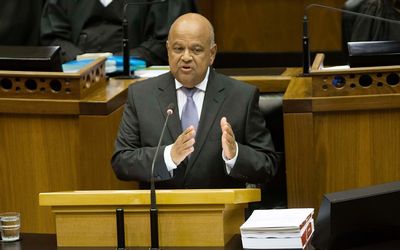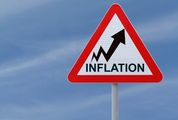WE WON’T know for some time whether Finance Minister Pravin Gordhan’s 2016 budget has done enough to avoid a ratings downgrade. His moves to cut expenditure, raise taxes (slightly) and accelerate the pace of fiscal consolidation were necessary to quell concerns over the country’s balance sheet, but the real question is whether or not the budget — and by extension Gordhan — has sufficient influence to bring about the long-run structural changes to the economy and shift in government ethos that is necessary for sustained growth.
Let me explain. From a purely budgetary perspective, Gordhan had one job: fiscal consolidation. The ratings agencies have quite rightly been worried that given SA’s rising debt, falling growth and consequently, falling revenues, we would be unable to repay our sovereign debt obligations.
In response to these concerns, Gordhan set a consolidated revenue target of R1.324-trillion for 2016-17 with a promise to stabilise national debt at 46.2% of gross domestic product by 2017-18 and reduce the budget deficit to 2.4% by 2018-19.
He has attempted to do this through modest tax increases — most notably an increase in capital gains tax and an increase in transfer duty on properties worth more than R10m — and by cutting the budgets of public entities, reining in unnecessary expenditure, and general all-round fiscal prudence.
He probably should have done more on the revenue side, but considering the pressure the economy is already under, this is as far as he can push the boat out for now.
Perhaps anticipating scepticism from the assembled media as to whether this would be enough to meet his revenue targets, Gordhan was frank about the constraints faced by the economy — and the budget — at a news conference prior to delivering his speech.
"You will see numbers in the budget that will, in part, contribute to fiscal credibility and, hopefully, reassure international rating agencies," he soothed from the front of the auditorium. It was here that he faltered just slightly: "Circumstances change leading up to budget and medium-term budget policy statements and we will make sure to choose the right tax instrument at the right time."
I genuinely appreciate the minister’s honesty regarding the challenges the Treasury faces in raising the necessary revenue during the next three years. His veiled admission that they might not have it all figured out, and that Treasury will have to adopt a wait-and-see approach to tax, oddly makes me more confident in his ability to fend off the ratings agencies.
But I also know the long-run outlook for SA’s sovereign credit rating is dependent on more than just meeting short-term debt expectations and obligations.
When Standard & Poor’s revised its outlook on SA’s debt in December from stable to negative and Fitch cut our credit rating by one level to BBB-, both cited external factors such as weak external demand and low commodity prices as part of the reason behind their assessment that growth might be lower than expected.
They also highlighted internal factors such as electricity shortages, labour disputes and weak business confidence that, in turn, inhibit private sector investment.
Indeed, speaking after Gordhan’s reappointment, Standard & Poor’s MD for Africa, Konrad Reuss, said economic growth was the biggest concern, although policy would remain under scrutiny.
In other words, even if Gordhan’s Budget Fantastic staves off an immediate downgrade, this budget needed to show a move towards economic policy that will generate stable and sustained growth and a willingness to make a fundamental shift in the way the government manages the business environment and interacts with the private sector.
Although Gordhan used a lot of familiar language when he spoke about how the budget is "guided by the National Development Plan" and that this is underpinned by "inclusive growth", "a strong mixed economy", "investment in infrastructure", and "improvements in the quality of education", he pulled no punches when it came to state inefficiency.
His mention of the findings of the Presidential Review Commission on state-owned enterprises (SOEs) that the mandates of some entities overlap and are no longer relevant to the country’s development agenda, and his announcement that SOEs that are no longer necessary will be phased out, sends a strong message that inefficiencies will be weeded out.
"We have too many SOEs, especially among the smaller and medium-sized ones," he said at the news conference. "And we would like to work towards a situation where the word ‘bail-out’ disappears from our vocabulary entirely."
What was particularly reassuring is that it seems there is finally an appetite for substantial private sector investment in large infrastructure projects the government can no longer afford.
That said, Gordhan was careful with his words. "We are not talking privatisation, we are talking co-investment and minority equity investments," he said.
This shift away from state-led growth and emphasis on the successes of other developing countries when they took steps to liberalise their economies was also encouraging. "We must address institutional and regulatory barriers to business investment and growth," he said.
"We must give greater impetus to sectors and industries where we have competitive advantages."
The special mention of scaling back subsidies for industry, opening up trade and encouraging the immigration of skilled workers suggests a move in the right direction for an economy that needs annual growth in excess of 3%.
Only time will tell. For now, I suspect the budget will buy us some time from the ratings agencies, but not much. Key infrastructural investments in energy, transport and housing, as outlined in the budget, need to serve as the nexus for the private sector investment that is necessary for growth — but only if they can show an adequate return on investment.
Thankfully, we have — I hazard to say — good examples of co-funding partnerships and concessions in the road-building and renewable energy space from which to draw.
There is no reason why these models should not be transposed onto other infrastructure projects that will serve as the basis for a new wave of private investment-led growth in the country.

Pravin Gordhan delivers his speech. Picture: TREVOR SAMSON
WE WON’T know for some time whether Finance Minister Pravin Gordhan’s 2016 budget has done enough to avoid a ratings downgrade. His moves to cut expenditure, raise taxes (slightly) and accelerate the pace of fiscal consolidation were necessary to quell concerns over the country’s balance sheet, but the real question is whether or not the budget — and by extension Gordhan — has sufficient influence to bring about the long-run structural changes to the economy and shift in government ethos that is necessary for sustained growth.
Let me explain. From a purely budgetary perspective, Gordhan had one job: fiscal consolidation. The ratings agencies have quite rightly been worried that given SA’s rising debt, falling growth and consequently, falling revenues, we would be unable to repay our sovereign debt obligations.
In response to these concerns, Gordhan set a consolidated revenue target of R1.324-trillion for 2016-17 with a promise to stabilise national debt at 46.2% of gross domestic product by 2017-18 and reduce the budget deficit to 2.4% by 2018-19.
He has attempted to do this through modest tax increases — most notably an increase in capital gains tax and an increase in transfer duty on properties worth more than R10m — and by cutting the budgets of public entities, reining in unnecessary expenditure, and general all-round fiscal prudence.
He probably should have done more on the revenue side, but considering the pressure the economy is already under, this is as far as he can push the boat out for now.
Perhaps anticipating scepticism from the assembled media as to whether this would be enough to meet his revenue targets, Gordhan was frank about the constraints faced by the economy — and the budget — at a news conference prior to delivering his speech.
"You will see numbers in the budget that will, in part, contribute to fiscal credibility and, hopefully, reassure international rating agencies," he soothed from the front of the auditorium. It was here that he faltered just slightly: "Circumstances change leading up to budget and medium-term budget policy statements and we will make sure to choose the right tax instrument at the right time."
I genuinely appreciate the minister’s honesty regarding the challenges the Treasury faces in raising the necessary revenue during the next three years. His veiled admission that they might not have it all figured out, and that Treasury will have to adopt a wait-and-see approach to tax, oddly makes me more confident in his ability to fend off the ratings agencies.
But I also know the long-run outlook for SA’s sovereign credit rating is dependent on more than just meeting short-term debt expectations and obligations.
When Standard & Poor’s revised its outlook on SA’s debt in December from stable to negative and Fitch cut our credit rating by one level to BBB-, both cited external factors such as weak external demand and low commodity prices as part of the reason behind their assessment that growth might be lower than expected.
They also highlighted internal factors such as electricity shortages, labour disputes and weak business confidence that, in turn, inhibit private sector investment.
Indeed, speaking after Gordhan’s reappointment, Standard & Poor’s MD for Africa, Konrad Reuss, said economic growth was the biggest concern, although policy would remain under scrutiny.
In other words, even if Gordhan’s Budget Fantastic staves off an immediate downgrade, this budget needed to show a move towards economic policy that will generate stable and sustained growth and a willingness to make a fundamental shift in the way the government manages the business environment and interacts with the private sector.
Although Gordhan used a lot of familiar language when he spoke about how the budget is "guided by the National Development Plan" and that this is underpinned by "inclusive growth", "a strong mixed economy", "investment in infrastructure", and "improvements in the quality of education", he pulled no punches when it came to state inefficiency.
His mention of the findings of the Presidential Review Commission on state-owned enterprises (SOEs) that the mandates of some entities overlap and are no longer relevant to the country’s development agenda, and his announcement that SOEs that are no longer necessary will be phased out, sends a strong message that inefficiencies will be weeded out.
"We have too many SOEs, especially among the smaller and medium-sized ones," he said at the news conference. "And we would like to work towards a situation where the word ‘bail-out’ disappears from our vocabulary entirely."
What was particularly reassuring is that it seems there is finally an appetite for substantial private sector investment in large infrastructure projects the government can no longer afford.
That said, Gordhan was careful with his words. "We are not talking privatisation, we are talking co-investment and minority equity investments," he said.
This shift away from state-led growth and emphasis on the successes of other developing countries when they took steps to liberalise their economies was also encouraging. "We must address institutional and regulatory barriers to business investment and growth," he said.
"We must give greater impetus to sectors and industries where we have competitive advantages."
The special mention of scaling back subsidies for industry, opening up trade and encouraging the immigration of skilled workers suggests a move in the right direction for an economy that needs annual growth in excess of 3%.
Only time will tell. For now, I suspect the budget will buy us some time from the ratings agencies, but not much. Key infrastructural investments in energy, transport and housing, as outlined in the budget, need to serve as the nexus for the private sector investment that is necessary for growth — but only if they can show an adequate return on investment.
Thankfully, we have — I hazard to say — good examples of co-funding partnerships and concessions in the road-building and renewable energy space from which to draw.
There is no reason why these models should not be transposed onto other infrastructure projects that will serve as the basis for a new wave of private investment-led growth in the country.














 News, views and analysis of Finance Minister Pravin Gordhan's 2016 budget
News, views and analysis of Finance Minister Pravin Gordhan's 2016 budget






Change: -0.47%
Change: -0.57%
Change: -1.76%
Change: -0.34%
Change: 0.02%
Data supplied by Profile Data
Change: -1.49%
Change: 0.08%
Change: -0.47%
Change: 0.00%
Change: -0.04%
Data supplied by Profile Data
Change: -0.34%
Change: 0.03%
Change: -0.10%
Change: -0.22%
Change: -0.69%
Data supplied by Profile Data
Change: -0.28%
Change: -1.15%
Change: -0.07%
Change: -1.21%
Change: -0.22%
Data supplied by Profile Data